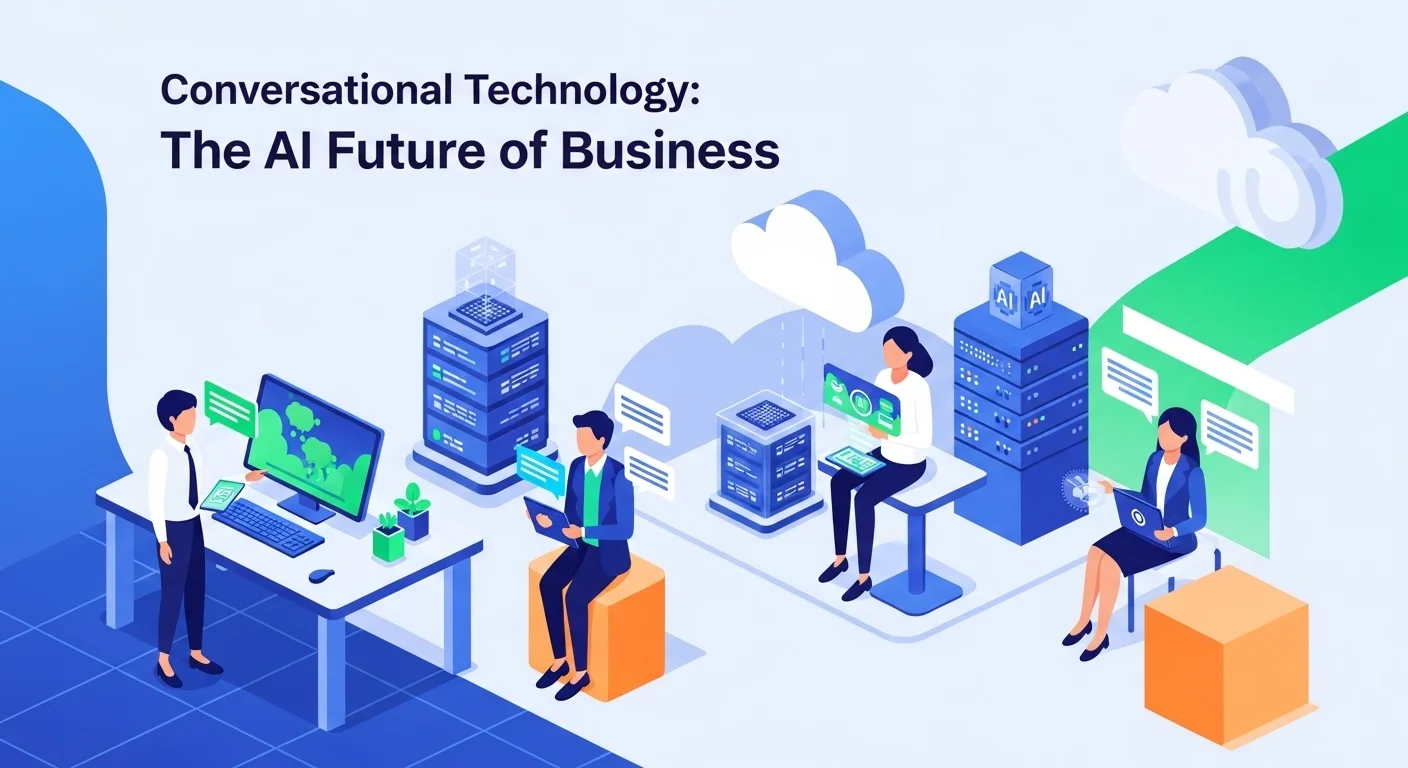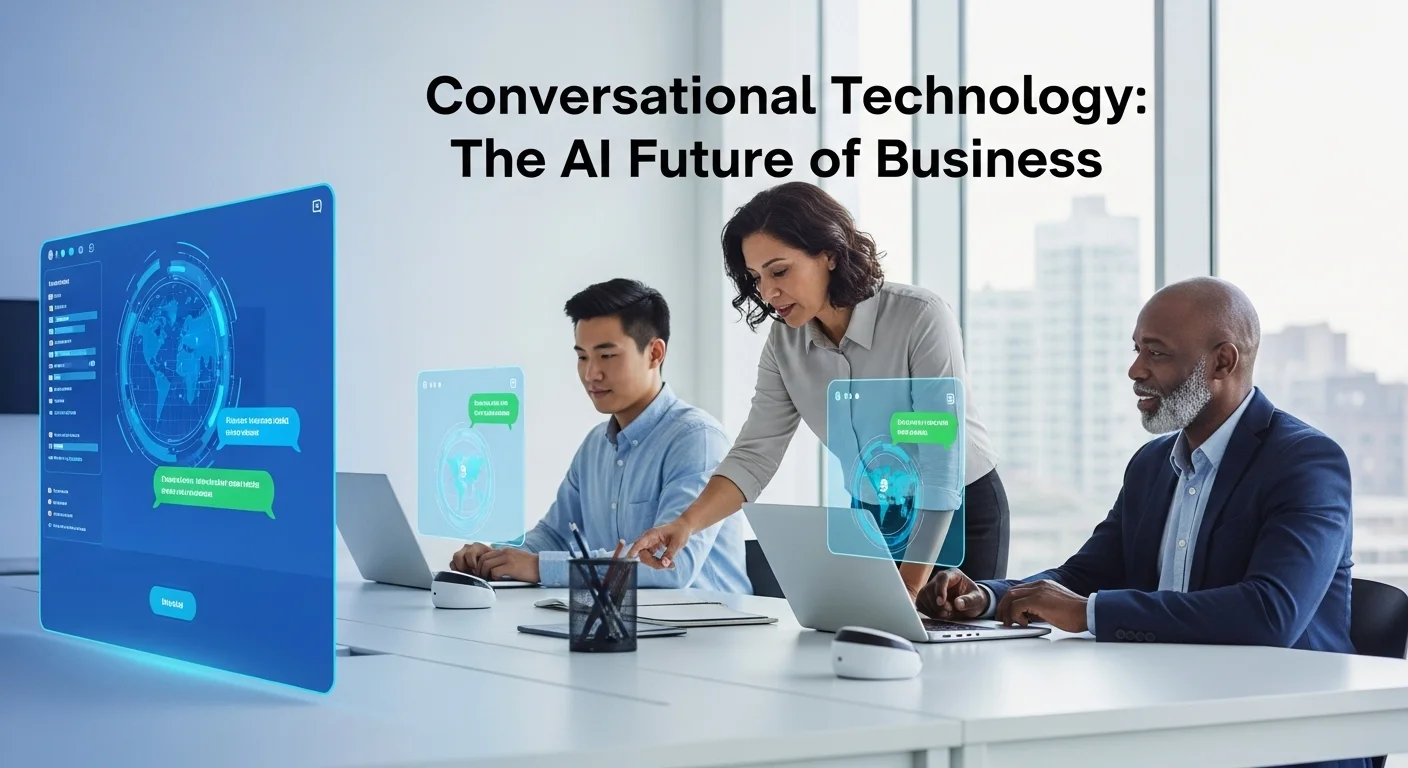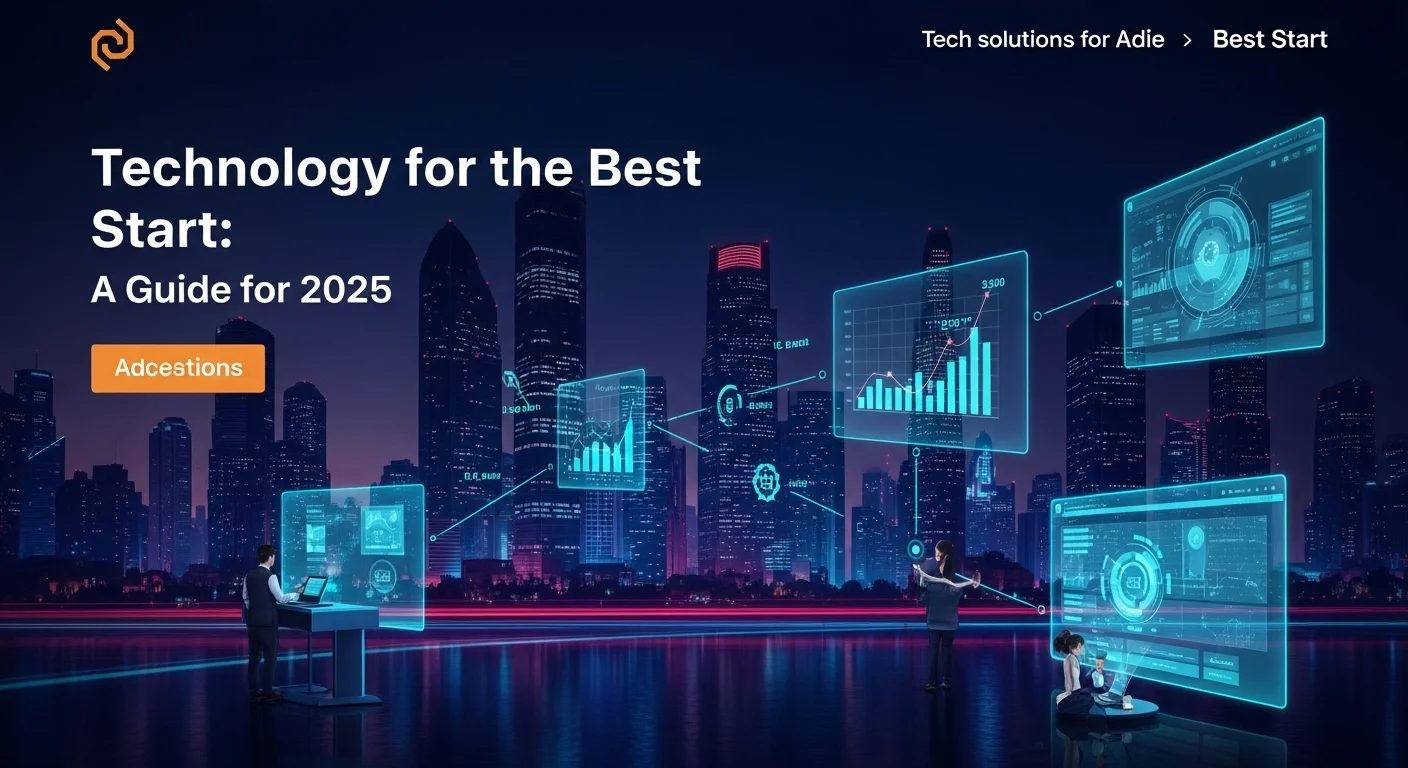Conversational AI: How It's Quietly Changing Your Business

Executive Summary
For years, I've watched businesses struggle to connect with customers online. The tools were clunky, the interactions impersonal. Then came conversational AI, and everything changed. We're moving beyond simple chatbots to create genuinely helpful, intelligent interactions. This isn't just about answering questions; it's about using AI to understand customer needs on a deeper level, transforming everything from customer service to data analysis. I've seen small startups and large corporations use this tech to get closer to their customers and make smarter decisions, faster. This guide is my attempt to cut through the jargon and show you, in simple terms, how conversational technology works and how you can make it work for your business. It's the roadmap I wish I'd had when I started.
Table of Contents
What is Conversational Technology, and Why Should You Care?
I remember a time when using software felt like navigating a maze of menus and buttons. To get anything done, you had to learn the machine's language. Today, that's flipping on its head. The world of conversational interfaces allows us to use our own language—words—to interact with technology. This isn't just a minor upgrade; it's a fundamental shift that makes technology more accessible, efficient, and, frankly, more human. At the heart of this revolution is conversational AI, a smart type of artificial intelligence built to chat with us in a way that feels natural. I've been in this space for a long time, and I've seen it evolve from clunky, frustrating bots to the sophisticated assistants we see today. This tech combines several fields like Natural Language Processing (NLP), machine learning, and others to not just hear our words but to understand our intent, context, and even our tone. It’s what makes these interactions feel meaningful and incredibly useful.
The Tech Behind the Talk: How AI Understands Us
So, how does this AI 'brain' actually work? It all starts when you type or speak a request.
Decoding Human Language with NLP and NLU
The first big challenge is making sense of human language, which is full of quirks and ambiguity. That's where Natural Language Processing (NLP) and Natural Language Understanding (NLU) come in. Think of NLP as the system that processes the language, and NLU as the part that figures out what you actually *mean*. For instance, if you ask, 'What's the forecast in London and will I need a coat?', the NLU model doesn't just see keywords. It identifies 'London' as a location, 'weather forecast' as the main goal, and the 'coat' question as a related query. It's smart enough to understand grammar, context from past chats, and slang to get to the real meaning. It’s the difference between a search engine and a real assistant.
Getting Smarter with Machine Learning (ML)
The best conversational AI systems never stop learning. They're built on machine learning models that improve with every single interaction. Each conversation provides new data that helps refine the AI's accuracy and expand what it can do. It's why a chatbot that struggles with a question one week might handle it perfectly the next. The recent explosion in Generative AI and Large Language Models (LLMs) has put this on overdrive. These models are trained on gigantic amounts of text, allowing them to generate responses that are incredibly fluent, context-aware, and almost indistinguishable from a human's.
Crafting the Perfect Reply with NLG
Once the AI understands you and knows what to say back, it needs to deliver that response in a clear, natural way. This is the job of Natural Language Generation (NLG). NLG takes the structured data and turns it into human-sounding text or speech. The goal isn't just to be grammatically correct, but to match the right tone for the conversation, whether it's a formal business chat or a casual inquiry.
Why Your Business Can't Ignore Conversational AI
From my experience, adopting conversational AI for business is no longer a 'nice-to-have'—it's becoming a core part of a modern strategy. The applications are transforming almost every part of a company. The market is booming for a reason.
A Revolution in Customer Experience
The most obvious impact is on customer service. We've all been there—stuck on hold or dealing with a bot that just says, 'Sorry, I don't understand.' Today's AI-powered assistants are different. They're available 24/7 on websites, apps, and messaging platforms to handle a huge range of tasks, from checking an order to troubleshooting a problem. By automating these routine queries, companies can free up their human agents to focus on the complex, emotional issues where they're needed most. I've seen this lead directly to lower costs, happier customers, and less-stressed employees.
Boosting Sales and Marketing
In sales and marketing, I see conversational AI as a tireless assistant that qualifies leads and nurtures potential customers. A chatbot can engage website visitors, ask smart questions, recommend products, and even schedule demos. That immediate, helpful interaction can be the difference between a visitor who leaves and a new customer. It creates a smooth, interactive journey that not only increases conversions but also gives you invaluable data on what your customers are looking for.
The Rise of Conversational Business Intelligence
This is where things get really exciting for me. One of the most game-changing applications is conversational business intelligence (CBI). For decades, getting insights from company data meant relying on analysts to run complex reports. It was a huge bottleneck. CBI breaks down that wall. It lets anyone in the company ask questions about data in plain English and get instant answers. A sales director can just ask, 'Who were our top performers in Q2?' and get a chart back in seconds. It puts the power of data into everyone's hands, fostering a culture where smart, data-driven decisions can be made on the fly. It turns data analysis from a chore into a conversation.
The Startup Scene Fueling the Future
A huge amount of this progress is driven by a vibrant ecosystem of conversational AI startups. These nimble companies are pushing the limits, creating specialized solutions for industries like healthcare, finance, and retail. Some are building no-code platforms that let businesses create their own advanced bots, while others are developing the core tech that powers the next generation of interaction. This intense competition means the technology is constantly getting better, more powerful, and easier to integrate into our work lives. In short, conversational technology is vital because it makes technology work the way we do. For any business, it offers a powerful combination of efficiency, better customer experiences, and smarter decision-making. Understanding conversational AI for business isn't just about keeping up with trends; it's about preparing for a future where talking to our technology is as natural as talking to a person.

Your Playbook for Bringing Conversational AI into Your Business
So, you're convinced. You see the potential of conversational technology. But where do you start? Over the years, I've seen many companies jump in too quickly and end up with a clunky bot that nobody wants to use. Integrating this technology successfully requires a strategy. This is my practical playbook for leveraging conversational AI, designed for anyone looking to turn this powerful tech into a real business asset.
Technical Choices: The Brains of the Operation
First, you need to understand the different types of 'brains' that can power your conversational tool. Your choice here depends on what you want to achieve.
1. The Old Way (Rule-Based) vs. The New Way (AI-Based)
Remember those frustrating automated phone menus where you had to 'press 1 for sales'? That's the spirit of a rule-based system. It follows a rigid script. If you say the right keyword, it gives a pre-programmed response. If you don't, it breaks. They are simple but extremely limited.
Modern conversational AI for business is, thankfully, AI-based. It doesn't rely on rigid rules; it learns from data. This allows it to understand what users mean, even if they phrase things differently. Within AI-based systems, there are two main flavors:
- Retrieval-Based Models: Think of this as a librarian with a massive, perfectly organized library of answers. When you ask a question, it finds and 'retrieves' the best possible response. It doesn't create new sentences, which makes it very reliable and great for customer service, where you need consistent, pre-approved answers.
- Generative Models: This is the new frontier, powered by Large Language Models (LLMs). These models are more like creative writers. They generate brand new responses on the fly. This makes conversations feel incredibly dynamic and human. The trade-off is that they need more power and careful oversight to make sure their creative answers stay accurate and on-brand.
The Implementation Roadmap: A 5-Step Technique
Deploying conversational AI for business is a journey, not a sprint. I've guided dozens of teams through this process, and this is the 5-step technique that consistently delivers results.
Step 1: Start with 'Why?'. Before you write a single line of code, have a brutally honest conversation with your team. What problem are you *actually* trying to solve? Is it to cut down on support tickets? Generate more qualified leads? Be specific and set measurable goals, like 'reduce customer wait times by 40%' or 'capture 20% more demo requests from our website.' This clarity is your north star.
Step 2: Pick Your Tools. The market is full of great platforms. Your choice depends on your team's skills, budget, and ambition.
- Google Dialogflow: This is a beast. It's powerful, scalable, and perfect for complex, enterprise-level projects.
- Microsoft Bot Framework & Azure AI: If your company already runs on the Microsoft ecosystem, this will feel like home. It's a comprehensive toolkit for developers.
- Rasa: For the tinkerers and control freaks, this open-source platform gives you maximum flexibility to build and customize everything yourself.
- No-Code Platforms: A growing number of tools offer drag-and-drop interfaces. These are fantastic for smaller businesses or for quickly building a prototype to test an idea.
Step 3: Design the Conversation. This is crucial. A good conversation flows naturally. Map out how you expect users to interact. What's their goal? Where might they get stuck? And please, give your bot a personality. Define its name, its tone, and how it talks. This small step makes a huge difference in user engagement.
Step 4: Train, Test, Repeat. You have to feed your AI with good data. This means gathering examples of real questions your customers ask. Once you have an early version, test it relentlessly. See where it breaks. And most importantly, have a graceful way to hand off to a human when the bot gets stuck. Launching the bot is just the beginning. You need to constantly monitor its conversations and use that feedback to retrain and improve it.
Step 5: Connect Everything. A standalone bot is useful, but an integrated bot is a powerhouse. Connect it to your CRM so it can recognize customers and personalize the chat. Link it to your inventory system so it can check stock levels. This integration is what elevates it from a simple Q&A tool to a system that can take real action for the user.
Making Data Talk: Harnessing Conversational BI
Applying this to conversational business intelligence (CBI) is all about making data accessible. A CBI system works by creating a 'translation layer' that connects everyday language to your complex databases. So when a manager asks, 'Show me last month's sales by region,' the system translates that into a database query, fetches the data, and presents it in a simple chart or summary. To make this work, your data has to be clean and trustworthy. I always advise starting small: pick one high-impact use case, like giving your sales team real-time access to their performance data. Once they see the value, adoption will spread like wildfire.
Navigating the Startup Ecosystem
The field is buzzing with innovative conversational AI startups. When you're looking for a partner, I find it helpful to group them:
- Platform Providers: They give you the tools to build your own bot.
- Industry Specialists: These startups focus on one area, like healthcare or finance. They come with pre-built knowledge that can save you a ton of time.
- Component Providers: Some focus on one specific piece of the puzzle, like super-advanced voice recognition or sentiment analysis.
Working with a startup can give you access to cutting-edge tech and specialized expertise. By following a clear plan and choosing the right tools, you can successfully implement a conversational strategy that transforms how you do business.

From Good to Great: My Top Tips for Conversational AI
Putting a conversational tool out there is one thing; making it an experience that people love is another. Over the years, I've seen firsthand what separates a frustrating bot from an intelligent assistant that genuinely helps. This isn't just about the technology; it's about the thoughtful design and strategy behind it. Here are my go-to tips and best practices to make sure your investment in conversational AI truly pays off.
Crafting an Unforgettable User Experience
The user experience (UX) is everything. If the interaction feels clunky or unhelpful, people won't use it. It's that simple.
1. Give Your Bot a Personality
A bot without a personality is just a glorified search bar. Before you do anything else, decide on its persona. Is it a friendly, cheerful helper? A formal, just-the-facts expert? This persona should be reflected in its name, its tone, and the way it phrases things. Consistency here makes the interaction feel surprisingly natural and builds a connection with the user.
2. Design for a Real Conversation
I see this mistake all the time: bots that are just a series of menus disguised as a chat. 'Press 1 for X, Press 2 for Y.' That’s not a conversation. A great design allows users to state their needs in their own words. While suggestion buttons can be helpful guides, the core of the experience should be about understanding what the user wants to say, not forcing them down a rigid path.
3. Master the Art of the Graceful Failure
Your AI won't be perfect. It will get stumped. The key is how it handles that moment. Instead of a dead-end 'I don't understand,' teach it to say something like, 'I'm still learning about that. Could you ask me in a different way?' or 'Here are some things I can help with.' Crucially, always provide an 'escape hatch'—an easy, obvious way for the user to connect with a human. Make sure the conversation history gets passed along so the user doesn't have to repeat themselves. This builds immense trust.
4. Use Analytics as Your Guide
Every conversation your bot has is a goldmine of feedback. Use your analytics to see what questions people are asking most, where they get confused, and at what point they give up. This data is your roadmap for improvement. I tell my clients that launching a bot is day one. The real work is in the continuous cycle of listening, learning, and refining.
Advanced Strategies to Maximize Your ROI
Once you have a solid foundation, you can start using your AI for more advanced, high-value strategies.
1. Engage Proactively and Get Personal
Don't wait for the user to start the chat. Use your conversational AI for business to be proactive. For example, if someone is lingering on a product page, the bot can pop up with a helpful, 'Hey, I see you're checking out our new running shoes. Have any questions about sizing?' If you connect your AI to your CRM, you can take this to another level. Greet returning customers by name and reference their past orders. This kind of personalized touch is incredibly powerful.
2. Embrace Conversational Commerce
Turn your bot from an information source into a sales channel. Let users browse products, ask questions, and complete their purchase, all within the chat window. This removes friction and makes buying easy, which almost always leads to higher conversion rates. I've seen companies have huge success by allowing customers to book appointments or schedule services directly through the chat.
3. Get Proactive Insights from Your Data
With conversational business intelligence (CBI), you can go beyond just asking questions. You can configure your system to push insights to you. Imagine your AI alerting a sales manager automatically when a team member is falling behind on their quota, or notifying marketing when a campaign is performing exceptionally well. This transforms your BI tool from a passive dashboard into an active, strategic advisor.
Choosing Your Tools and Partners
The right tool can make all the difference. Beyond the big players like Google and Microsoft, the world of conversational AI startups is where a lot of the most exciting innovation is happening. When you're picking a partner, I always suggest you look at three things:
- Integration: How well does it play with the systems you already use?
- Scalability: Can it grow with you as your needs become more complex?
- Expertise: Does the vendor truly understand your industry and its challenges?
Looking Ahead
This field is moving incredibly fast. We're heading towards a future where AI can understand a mix of text, voice, and images all at once. As this tech becomes more powerful, our focus on ethics—on fairness, transparency, and privacy—must grow with it. To really stay ahead, I always recommend keeping an eye on what experts from top academic institutions, like those at MIT Sloan, are saying about integrating these new technologies into business strategy. Their insights are invaluable for thinking long-term.
In the end, mastering conversational technology is a journey of continuous learning. By focusing on the human experience, using smart business strategies, and choosing the right partners, you can build something that's not just efficient, but genuinely engaging and valuable. It's how you turn a simple chatbot into a cornerstone of your digital success.
Expert Reviews & Testimonials
Sarah Johnson, Business Owner ⭐⭐⭐⭐
As a small business owner, I was worried this would be too technical. But the 5-step plan in Part 2 was incredibly clear. It gave me a practical framework to think about how a chatbot could actually help us, not just be another gadget.
Mike Chen, IT Consultant ⭐⭐⭐⭐
Finally, an article that explains the difference between retrieval and generative models without putting me to sleep! The analogies were super helpful. A great read for any IT pro trying to explain this tech to non-technical stakeholders.
Emma Davis, Tech Expert ⭐⭐⭐⭐⭐
This is one of the best overviews I've read. David's personal insights are what set it apart. The section on conversational business intelligence, in particular, opened my eyes to possibilities beyond customer service bots. Bookmarking this for my team.



